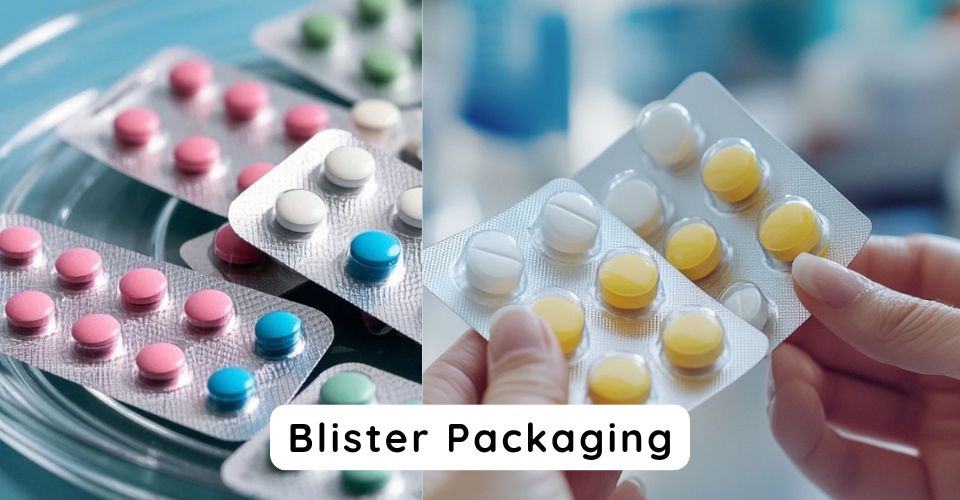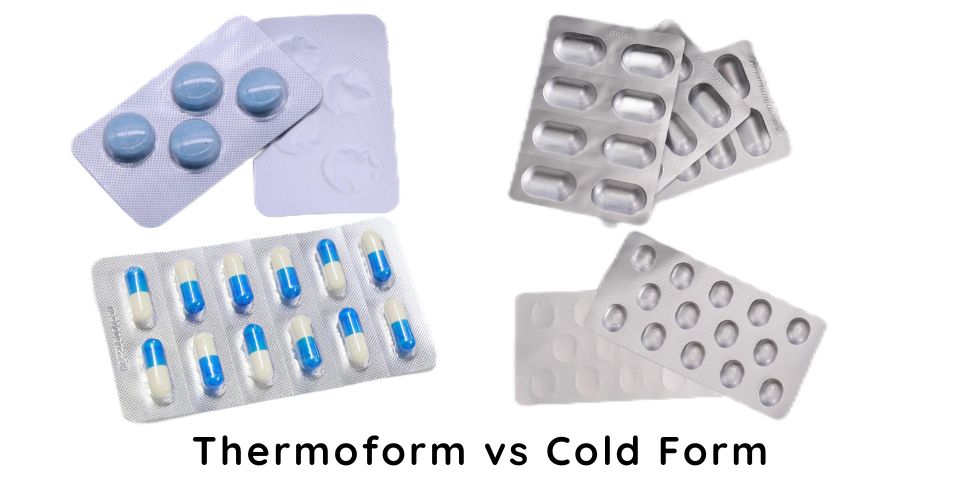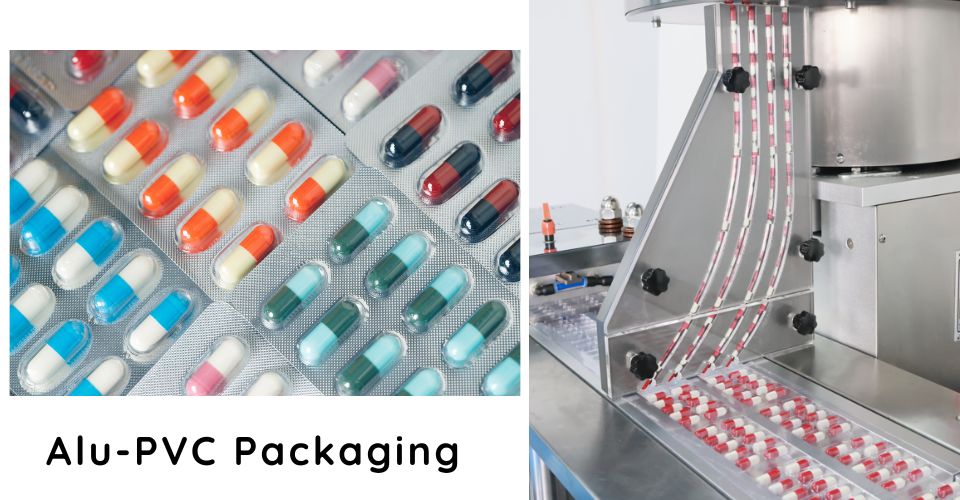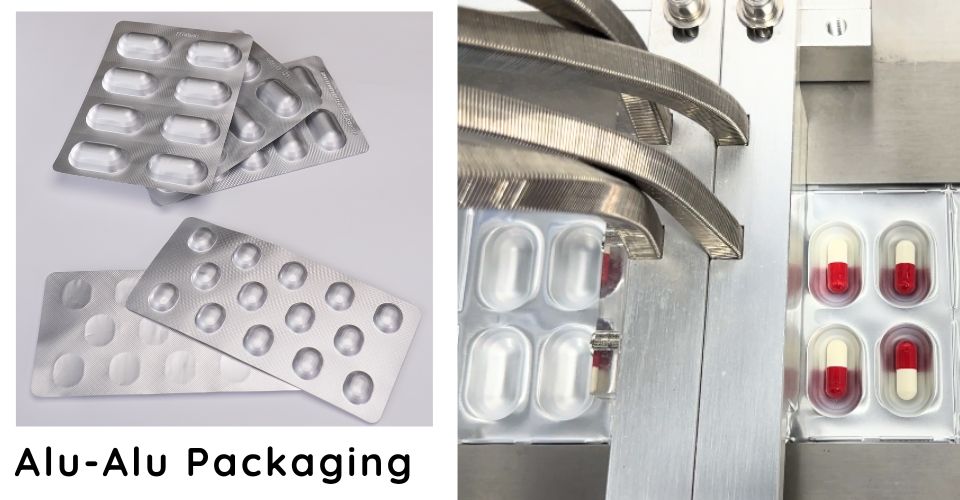I blister e le macchine confezionatrici in blister sono ampiamente utilizzati nei settori farmaceutico, nutraceutico e dei beni di consumo. Dalla protezione dei farmaci al confezionamento di giocattoli ed elettronica, i blister offrono protezione, praticità e un impatto visivo gradevole. Questa guida completa esplora cos'è il confezionamento in blister, le diverse tipologie, i suoi vantaggi, il funzionamento delle macchine confezionatrici in blister e come scegliere la soluzione giusta per la tua attività.

UN blister è un tipo di imballaggio in plastica preformato utilizzato per contenere singole unità di prodotti. In genere include una cavità o una tasca realizzata in PVC, PET o foglio di alluminio , sigillato con un supporto fatto di carta, plastica o alluminio I prodotti confezionati in questo modo, come i medicinali in blister, sono protetti da fattori ambientali quali umidità, contaminazione e manomissione.

Confezionamento in blister Si riferisce al processo e ai materiali utilizzati per creare blister. Consiste nella termoformatura o formatura a freddo di materiali in tasche o cavità che racchiudono un prodotto, per poi sigillarle con un materiale di supporto. Questo metodo di confezionamento è molto comune per prodotti farmaceutici e integratori, come i farmaci in blister.

• Protezione del prodotto : Protegge da umidità, contaminazione e danni. I blister medicali preservano l'integrità del farmaco e ne prolungano la durata di conservazione.
• Precisione del dosaggio : Aiuta i pazienti a monitorare l'assunzione con blister di pillole, blister di farmaci e blister di capsule.
• Branding e conformità : Costume Gli imballaggi blister, gli imballaggi blister in plastica e gli imballaggi blister in carta migliorano l'attrattiva sugli scaffali.
• Versatilità : Adatto ai settori farmaceutico, nutraceutico, elettronico, della bellezza e dei giocattoli.
• Farmaci in blister : S come capsule in blister e compresse in blister, comunemente presenti nei prodotti da banco come i blister di paracetamolo o vitamine capsula C vescica confezioni, garantendo una protezione ermetica e un comodo controllo del dosaggio.
• Confezionamento blister medicale: Per dispositivi e integratori come bisturi e lame, siringhe e aghi, forbici chirurgiche, ecc., è importante garantire la sterilità e la conservazione sicura utilizzando carta per dialisi e blister in PVC o confezioni blister personalizzate. Ad esempio, le siringhe presterilizzate in blister monouso contribuiscono a mantenere l'igiene negli ambienti clinici.
[se !supportLists] • Confezionamento in blister di beni di consumo: Per giocattoli, batterie e piccoli beni di consumo come chiavette USB, auricolari e accessori, spesso confezionati in blister a conchiglia o in blister con chiusura a scatto per prevenire manomissioni e furti. Ad esempio, le batterie AA sono solitamente vendute in blister sigillati con parte anteriore in plastica trasparente e parte posteriore in cartone.
• Confezione blister monodose per farmacia: Molte farmacie utilizzano blister monodose per preparare i farmaci da prescrizione per i pazienti , In particolare per i trattamenti di malattie croniche. Ad esempio, una farmacia può riconfezionare le compresse per una settimana o un mese in blister calendarizzati, con ogni cavità etichettata per giorno o ora (ad esempio, "Lunedì mattina", "Lunedì pomeriggio"), per migliorare l'aderenza del paziente alla terapia e ridurre gli errori terapeutici.
|
Industria |
Esempi di prodotti |
Obiettivi di imballaggio |
|
Farmaceutica e integratori |
Capsule, compresse |
Protezione dall'umidità, precisione del dosaggio |
|
Bellezza |
Maschere per il viso, sieri |
Appeal a scaffale, igiene, porzioni monouso |
|
Giocattoli |
Action figure, accessori |
Prevenzione furti, esposizione prodotti |
|
Elettronica |
Batterie, chiavette USB |
Sigillo di sicurezza, prova di manomissione |
Il confezionamento blister è comunemente utilizzato in molti prodotti. Sebbene i formati esterni possano variare, esistono due metodi principali per realizzare le cavità dei blister: il confezionamento blister tramite termoformatura e il confezionamento blister tramite formatura a freddo. Ogni metodo presenta processi, requisiti dei materiali e vantaggi applicativi distinti.

[se !supportLists] • Confezionamento blister termoformato consiste nel riscaldare un foglio di plastica, comunemente PVC, PET o PVDC, fino a renderlo malleabile, per poi modellarlo in cavità tramite vuoto o pressione. Queste cavità vengono successivamente sigillate con un materiale di copertura, in genere un foglio di alluminio.
• Confezionamento blister a freddo g, noto anche come imballaggio blister alu-alu, utilizza un laminato di alluminio, PVC e poliammide (nylon) che si forma in cavità attraverso stampaggio ad alta pressione , senza l'applicazione di calore.
|
Caratteristica |
Confezionamento blister termoformato |
Confezionamento blister a freddo |
|
Metodo di formatura |
Foglio di plastica riscaldato modellato in cavità. |
Laminato a base di alluminio ottenuto mediante pressatura a freddo. |
|
Materiale utilizzato |
PVC, PVDC, PET, Aclar. |
Laminato in alluminio + nylon + PVC. |
|
Proprietà barriera |
Barriera moderata tra umidità e ossigeno. |
Ottima barriera (umidità, luce, ossigeno). |
|
Chiarezza/Visibilità |
Trasparente, consente la visibilità del prodotto. |
Opaco, nessuna visibilità del prodotto. |
|
Costo |
Minori costi dei materiali. |
Costi di produzione e materiali più elevati |
|
Velocità di produzione |
Velocità di formatura più rapida, maggiore efficienza. |
Processo di formatura più lento grazie alla pressatura a freddo |
|
Uso preferito |
Farmaci da banco, integratori, dove la visibilità è un vantaggio. |
Farmaci sensibili all'umidità, ad esempio antibiotici o biologici. |
|
Stampa |
Facile da stampare direttamente sulla lamina posteriore o sulla carta. |
Stampa solo sullo strato superiore; più limitata rispetto alla termoformatura. |
Tra i due principali metodi di confezionamento in blister che formano le cavità del blister, il confezionamento in blister è disponibile in diversi tipi e formati, ognuno progettato per soddisfare specifiche esigenze di prodotto e standard di settore.
1) Tipi comuni di confezionamento in blister
|
Tipo |
Descrizione |
Esempio |
|
Confezione blister a conchiglia |
Guscio di plastica incernierato e ripiegato su se stesso, solitamente dotato di meccanismo di bloccaggio. |
Batterie, accessori per telefoni, utensili o giocattoli in confezioni per la vendita al dettaglio per prevenire furti e manomissioni. |
|
Imballaggio blister intrappolato |
Blister posizionato tra due strati di cartone stampato, per garantire visibilità e un marchio forte. |
Prodotti di alta gamma. Spesso utilizzati per cuffie, chiavette USB o utensili per hobby in confezioni per la vendita al dettaglio che necessitano sia di sicurezza che di un'estetica accattivante. |
|
Confezione blister scorrevole |
Prodotto in un blister che scorre in una custodia di cartone. |
Spazzolini da denti, rasoi e piccoli dispositivi elettronici che traggono vantaggio da imballaggi riutilizzabili e adatti all'esposizione. |
|
Confezione blister con sigillo facciale |
Blister sigillato su un supporto di cartone piatto, che copre solo l'area del prodotto. |
Capsule e compresse in farmacia al dettaglio o per articoli di consumo come penne e cosmetici. |
|
Guarnizione facciale completa |
Il blister ricopre l'intera superficie della carta ed è sigillato ad essa. |
Farmaci da banco. |
|
Confezione blister monodose |
Ogni cavità contiene una dose, con etichette stampate (data/ora). |
Compresse per la pressione sanguigna o per il diabete per una settimana, in confezioni etichettate (ad esempio, "Lunedì mattina", "Martedì pomeriggio") per i pazienti. |
|
Confezionamento blister conforme |
Blister progettati con istruzioni stampate per migliorare l'aderenza del paziente alla terapia. |
Sperimentazioni cliniche, monitoraggio del rinnovo delle prescrizioni, compliance del paziente. |
2) Popolare F formati di B Lister Packaging
|
Tipo |
Descrizione |
Applicazioni chiave |
|
Alluminio-PVC |
La plastica termoformata in PVC forma delle cavità, sigillate con un foglio di alluminio. |
Farmaci da banco comuni blister farmaci come paracetamolo, ibuprofene e integratori. |
|
Alluminio-alluminio (formatura a freddo) |
Sia lo strato di formatura che quello di copertura sono realizzati in foglio di alluminio. |
Farmaci sensibili alla luce e all'umidità, ad esempio antibiotici, antiepilettici. |
|
Imballaggi in carta e PVC |
Il PVC termoformato forma cavità principalmente con carta per dialisi medica. |
Strumenti per il confezionamento in blister medicali, come siringhe, set per infusione, bisturi, cateteri, ecc. |
|
Alluminio-PVC/PVDC |
Base in PVC con rivestimento in PVDC |
Farmaci a sensibilità moderata che richiedono una migliore protezione durante la conservazione. |
|
Alluminio-PVC/PE/PVDC |
Pellicola multistrato di PVC, PE e PVDC per migliorare la flessibilità di formatura e le proprietà barriera. |
Prodotti farmaceutici e medicinali leggermente sensibili esportati. |
|
PET (polietilene tereftalato) |
Plastica resistente e ad alta trasparenza, con buona rigidità e resistenza agli urti. |
Beni di consumo come batterie e utensili. |
Per soddisfare la domanda industriale, vari macchine confezionatrici blister Sono state sviluppate macchine per blisteratura. Queste macchine automatizzano l'intero processo di produzione dei blister, inclusi la formatura, l'alimentazione del prodotto, la sigillatura e il taglio. A seconda del metodo di formatura e della combinazione di materiali, le macchine sono generalmente classificate in due tipologie principali:
Le macchine blisteratrici in alluminio-PVC utilizzano un sistema di riscaldamento per ammorbidire il PVC o altri film plastici termoformabili, che vengono poi modellati in cavità utilizzando uno stampo di formatura. Dopo la formatura, prodotti come compresse o capsule vengono automaticamente inseriti nelle cavità. Le cavità vengono quindi sigillate con un foglio di alluminio utilizzando un meccanismo di termosaldatura. Le confezioni blister in alluminio-PVC sono ampiamente utilizzate nell'industria farmaceutica e degli integratori per la loro elevata velocità di produzione, la chiara visibilità del prodotto e la tenuta stagna.

Caratteristiche principali:
• Adatto per linee di produzione ad alta velocità.
• La plastica trasparente consente l'ispezione visiva dei prodotti.
• Forme flessibili e design delle cavità.
• Ideale per compresse standard, capsule, pastiglie e piccoli dispositivi medici.
A differenza della termoformatura, Le macchine blisteratrici Alu-Alu, note anche come macchine formatrici a freddo, utilizzano la pressione meccanica per modellare un film di alluminio laminato in cavità blister senza bisogno di calore. Queste cavità vengono quindi riempite e sigillate con un foglio di alluminio, creando un blister completamente opaco e a tenuta d'aria. Questo tipo di blister offre una protezione superiore contro umidità, ossigeno e luce, rendendolo la soluzione ideale per prodotti farmaceutici fotosensibili o altamente igroscopici.

Caratteristiche principali:
• Eccellenti proprietà barriera (umidità, ossigeno, luce UV).
• Durata di conservazione prolungata per i farmaci sensibili.
• Imballaggio completamente opaco per un'elevata protezione.
• Velocità di produzione leggermente inferiore e costi dei materiali più elevati rispetto alle macchine termoformatrici.
Se vuoi saperne di più su come scegliere tra Imballaggi in alluminio-alluminio vs alluminio-PVC, per informazioni più dettagliate puoi fare riferimento a questo articolo: Alluminio-alluminio vs Alluminio-PVC: come scegliere il giusto imballaggio farmaceutico
Selezionare il giusto fornitore di imballaggi blister è fondamentale per garantire una qualità costante, la conformità alle normative e una produzione economicamente vantaggiosa. Che si tratti di prodotti farmaceutici, integratori o beni di consumo, un fornitore affidabile può avere un impatto diretto sulla sicurezza, la durata di conservazione e la presentazione del prodotto.
• Esperienza nel settore e competenza tecnica: Cercate fornitori con anni di esperienza nella produzione di macchine e materiali per il confezionamento automatico in blister. Devono conoscere gli standard del vostro settore, che si tratti di conformità alle GMP per i prodotti farmaceutici o di materiali di qualità alimentare per gli integratori.
• Capacità di personalizzazione: I tuoi prodotti potrebbero richiedere tipologie di imballaggio specifiche, come PVC/alluminio, alluminio/alluminio o carta-PVC. Un buon fornitore dovrebbe offrire flessibilità di progettazione, personalizzazione degli utensili e compatibilità con i materiali.
• Assistenza e formazione post-vendita: Le macchine blisteratrici necessitano di installazione, manutenzione e formazione degli operatori. Scegliete un fornitore con un solido supporto clienti, disponibilità di ricambi e assistenza tecnica da remoto o in loco.
• Conformità e certificazioni: Verificare che il fornitore rispetti gli standard pertinenti come CE, ISO, ROHS e cGMP. Ciò garantisce qualità e un ingresso agevole sul mercato, soprattutto nei settori regolamentati.
• Servizio e spedizione globali: Se ti rifornisci a livello internazionale, valuta se il fornito